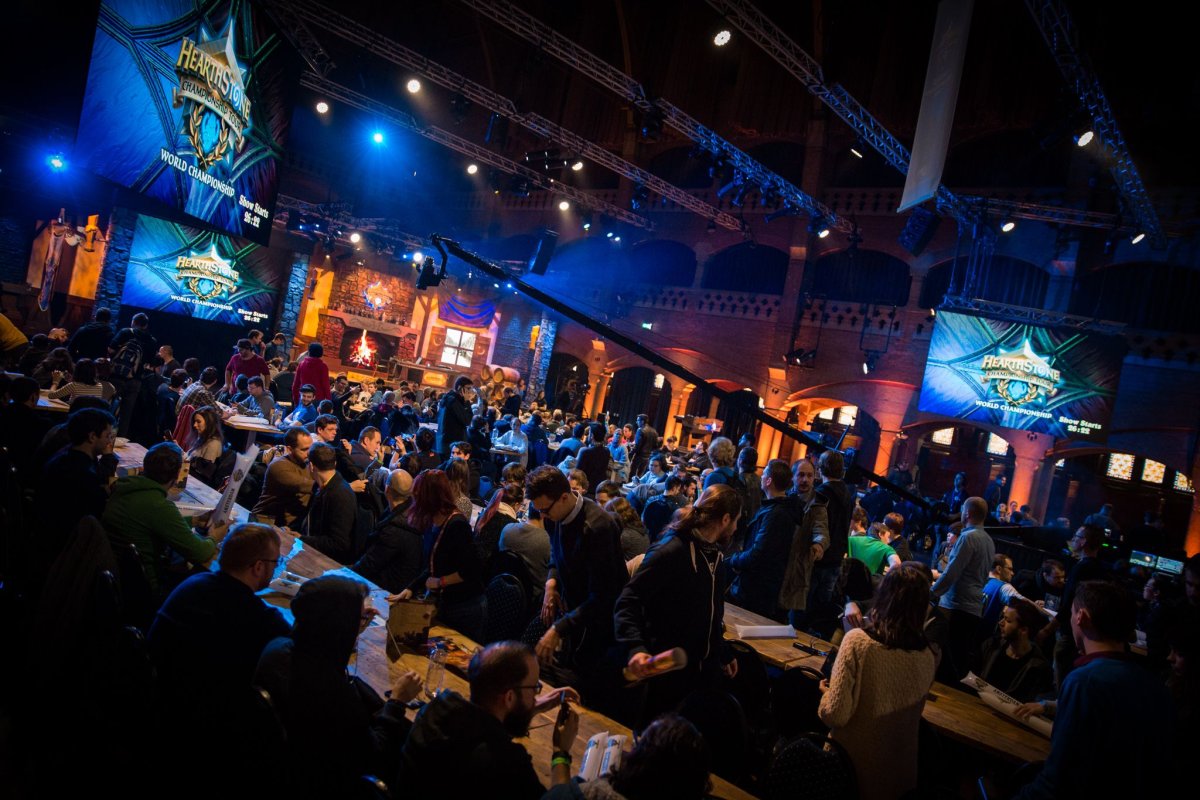
Beside the canals and sex shops of Amsterdam, the Beurs van Berlage Conference Centre holds steadfast. It's early January, and record-breaking winds pummel its exterior. The occasional brick falls to the street below as road signs get uprooted from the pavement. The people inside barely notice. They're fixated on giant monitors hanging from the rafters, watching the matches of the Hearthstone Championship Tour World Championship, a spectacle one year in the making with a million-dollar prize pool and fans all around the world watching. It's the game's biggest event of the year, with Blizzard touting it as the virtual card game equivalent of the World Series and Super Bowl.
Hearthstone is, despite its fantastic trappings, a simple card game.Creating live events that engage in-studio and online audiences wasn't as easy as just pointing a camera at a screen and broadcasting a stream.
"This event is a culmination of two years of work and is where we really wanted to go," Matt Wyble, Esports Manager for Hearthstone told Newsweek.

Before Hearthstone was a gaming juggernaut with more than 70 million players, Wyble and the rest of the Team 5 developers talked for hours about what could set HS esports apart from their competition. To them, pro play is just as important as any in-game feature, something that anyone that's gone as far as the first bit of dialogue from the in-game menu can understand. And it has to be consistent. All of the graphics, effects and dragon fire particles that appear on stream have to be approved by Hearthstone's final design team. Some are reused assets; flying cards are repurposed 3D models and the Hearthstone tome seen at the start of every commercial break was taken straight from the one of the game's cinematics.
"When we started thinking about esports events, we drew on our experiences as a team," Wyble said. "I like it when we lean into the magic we have, focusing on the things that are unique to us."
Unlike other esports titles that are often tied to PCs and consoles, Hearthstone is a mobile game that can be played nearly anywhere. Blizzard's esports team knew capitalizing on this strength would be essential for growth; Wyble wanted fans to experience the atmosphere of a tavern, not a virtual arena. That meant they'd have to completely rethink the traditional esports viewing experience. Chairs and monitors alone weren't going to cut it.
Bright purple, orange and blue lights accent the stage, with fantastical weaponry and portraits lining the walls next to a roaring (virtual) fireplace. In the crowd, picnic tables replace chairs, creating an ambiance straight out of nerd summer camp.
"We started tinkering with the table idea and that little tweak changes the whole tournament's aesthetic," Wyble said. "We're in uncharted territory, making up the rules as we go along." Other additions, like a seperate tavern room where fans can enter tournaments and charge their devices bring people together in a way other esports tournaments simply cannot.

Flashy graphics and high production values don't mean anything if people can't understand what's happening in the game. That job falls on pairs of casters who explain play-by-play action to viewers, helping everyone from the newest player to the seasoned veteran understand Hearthstone's spell-slinging action.
"The role of a caster isn't to tell everyone what they should be doing, it's to tell a story of what the players are doing rather than what they should do," caster Brian Kibler told Newsweek.
Kibler is in the Magic The Gathering Hall Of Fame and has decades of history in the competitive card game scene. He sees how Hearthstone viewers apply pro strategies to their own games. " Hearthstone is super successful at engaging players on a more casual level," Kibler said. "It's really important to realize most of your audience doesn't need top-level analysis, they are looking to understand basic issues." Understanding why a play was made, rather than openly calling it a misplay can allow viewers to understand high-level strategies they otherwise would never consider.
Preparing for an event of this size isn't easy, but Kibler has hundreds of thousands of hours of Hearthstone play under his belt, and streams six to seven hours a day on his Twitch channel. Understanding the names of the cards in each player's deck and the key patterns for how the decks operate is a must; looking silly on-camera is not an option. Kibler had to get inside the heads of these pro players: playing Frank "Fr0zen" Zang's decks on stream and meeting up with Jon "Orange" Westberg for dinner to discuss strategy. Hearthstone esports has come a long way since those original meetings at Blizzard, growing into a team of hundreds.
"If someone were to see the sheer size of the crew that it takes to put on a show like this, they'd be shocked," Kibler said. "There's hundreds of people working behind the scenes who do so much to make the actual broadcast happen."
Uncommon Knowledge
Newsweek is committed to challenging conventional wisdom and finding connections in the search for common ground.
Newsweek is committed to challenging conventional wisdom and finding connections in the search for common ground.
About the writer
Steven Asarch is a tech reporter for Newsweek currently based in New York City. In high school, he started stand-up ... Read more
To read how Newsweek uses AI as a newsroom tool, Click here.








